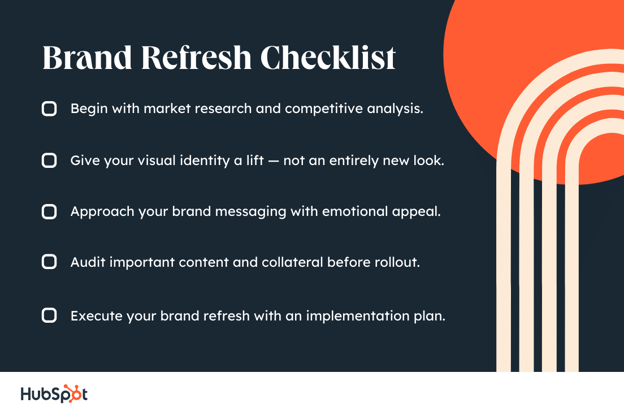Brand Refresh vs Rebrand: Which is Best for You? [+Checklist]

By ttaylor@hubspot.com (Tristen Taylor)
Brands that aren’t constantly evolving run the risk of becoming outdated or irrelevant. Some of the most popular brands of today would not have made waves unless they had undergone rebrands or refreshes.
For example, Apple is an excellent example of successful rebranding. In the early 1990s, Apple was slowly dropping out of the computer market. Apple updated its iconic logo from the dated rainbow to a sleeker, monochrome look to signal the change in its brand image. Of course, that wasn’t the only change, but it did mark the beginning of a new era for Apple. Today, they’re one of the most widely recognized brands in the world.
So, what’s the right solution for your client? In this post, we’ll discuss what exactly it means to rebrand or refresh your business strategically and stand the test of time.
It’s more of a risk for a business to remain stagnant than to attempt to change in any developing market. With business trends coming and going, businesses looking to refresh their identity would change elements such as:
- Logo
- Font
- Color Palette
- Brand Slogan
- Writing Style
But sometimes, it takes much more than just updating a logo or font, some businesses may need to make core changes to avoid the risk of losing competitive edge — by conducting a rebrand.
Think of rebranding as a series of substantial changes made to breathe life back into a struggling company. This process is more in-depth and can change elements of business including:
- Brand Positioning
- Brand Values
- Brand Guidelines
- Mission and Vision Statements
These can be time-consuming, expensive, and need a lot of approval to conduct, so if you’re looking to make more immediate changes for businesses, let’s dive into brand refresh strategy.
Brand Refresh Strategy
Use the steps below to guide your client through a successful refresh — but encourage them to adjust each step to fit the needs and audience of their company.
1. Determine if you need a brand refresh or a rebrand.
Perhaps your client has verbalized her desire to rebrand, but you should figure out its purpose before you even jump straight into rebranding. You should consider other avenues if your client can’t present a concrete reason (and “I’m bored” doesn’t count).
Why do you need to do this first? Rebranding isn’t as simple as slapping on a new logo or changing your name. Companies have to be willing to change their entire company vision, including company goals, message, and culture.
It takes a lot of time, money, and effort to pull a rebrand off successfully, and those that aren’t fully committed will be stuck with a poorly defined brand that will not stand out in today’s competitive market.
So how do you know if you should encourage your client to take that giant leap to rebrand? Here are some great cues:
- The brand has plans to expand the …read more
Source:: HubSpot Blog








